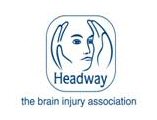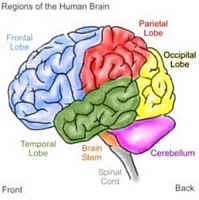ABOUT BRAIN INJURY
This information is also available in Headways 'Basic brain information' factsheet.
Brain facts
- Your brain weighs about 3lbs, or just under 1.5Kg
- It has the texture of blancmange
- Your brain is connected to your spinal cord by the brain stem
- Behind your brain stem is the cerebellum
- The cerebral cortex is the largest part of your brain. It contains the frontal lobes, the motor cortex, sensory cortex and parietal lobes
- The brain is made up of around 100 billion nerve cells and even more support cells, which provide nourishment to the nerve cells
Damage to a particular area can affect that activity. Strokes tend to affect a specific area of the brain, whereas a head injury due to a road traffic accident usually involves more general damage.
We also know that the left side of your brain controls your right side. So if someone had a stroke, which affected the left side of their brain, it would be likely that the right side of their body would be affected. For most of us, the left side controls speech, while the right side controls our artistic skills such as drawing and music.
Cerebral Cortex
The largest part of the brain is known as the cerebral cortex and is shaped like a large wrinkled walnut. It is divided into two halves and joined by a bridge in the middle. The two halves are known as the right and left cerebral hemispheres. It is known that the right side controls the left side of our body and the left side controls the right side of our body.
Damage only to the right side may affect movement in the left arm and leg or hearing in the left ear. There is also evidence that for most people the left hemisphere contains the language centres involving speech, while the right hemisphere tends to control non-language, spatial skills such as drawing or musical ability.
If a person received injuries only to the left side of the brain, by for example having a stroke, it is likely that speech would be affected, as would the ability to move the right side of the body.
Apart from dividing into a left and right hemisphere, the cerebral cortex can be further divided into a number of areas known as lobes.
Frontal Lobe
The frontal lobe is the area behind the forehead and is heavily involved in intellectual activities such as planning and organising, as well as being involved in personality and the control of emotions and behaviour.
Motor and Sensory Cortices
Between the frontal and parietal lobes is the motor cortex which controls movement and the sensory cortex which controls sensation.
Temporal Lobes
Nestled behind the ears, this area holds the bulk of our memories and our ability to understand things and speak.
Parietal Lobes
Located at the back of the brain above the ears, these have an important role to play in our ability to understand spatial relationships.
Occipital Lobe
At the very back of the head are the occipital lobes, which are responsible for sight. Any injury to this area can cause partial or complete blindness.
Internal areas of the brain
Hidden in the middle of this walnut-like cerebral cortex are a number of small white nerve centres, collectively known as the diencephalon. In this area lies the small pea-sized hypothalamus, which controls appetite regulation, sexual arousal, thirst and temperature control, and some aspects of memory.
Close to this area is another important set of nuclei, referred to as the limbic system. Damage to this area can play havoc with emotions, leaving the individual with dramatic and sudden mood swings.
Cranium and brain stem
The brain is completely surrounded by a hard, protective, rounded shell of bone, known as the skull or cranium. The important thing to remember about the skull is that underneath the front there are a number of bony ridges. When the soft tissue of the brain is shaken around, these ridges have the unfortunate effect of lacerating and damaging the underside of the front of the brain.
On the floor of the skull is a hole where the lower part of the brain or brain stem is connected to the spinal cord, and from there to the whole of the nervous system and the rest of the body. The brain stem is rather like a thick telecommunications cable, with countless nerve fibres like wires, carrying messages backwards and forwards. This brain stem area is also known to control such bodily functions as wakefulness, consciousness, tiredness, heartbeat and blood pressure. Damage to this area is thought to cause concussion and loss of consciousness.
Texture and blood vessels
The texture of the brain is rather like soft blancmange, but is held together in the skull by a number of layers of membrane called the dura, pia and arachnoid.
Between the pia and arachnoid membranes is the subarachnoid space, in which run the blood vessels supplying and draining the brain. Like any organ, the brain is dependent on blood from the heart, and is criss-crossed by a network of large arteries, which divide into progressively smaller branches. When the brain is shaken about in a head injury, these vessels tear and bleed. As people get older, the blood vessels become more brittle and more likely to tear if shaken around. This bleeding leads to a build-up of blood clots, which pressurises and damages the delicate tissue of the brain.
The brain in its membranous sack floats in a sea of cerebrospinal fluid, which fills in all the gaps around the brain and offers some protection and cushioning. Just behind the brain stem sits a curved lump of tissue called the cerebellum. This area regulates all of a person's fine motor co-ordination which is involved in such skills as balancing, moving quickly and gracefully, dancing, threading a needle, or climbing a ladder.
Nerve cells
The make up of the brain consists of billions of microscopic nerve cells. Under a powerful microscope these cells look like small dots with a network of hair like tentacles (axons and dendrites). They communicate with each other by passing electrical and chemical impulses between these tentacles. Highly complex patterns of communication, or pathways, build up as the brain develops throughout childhood.
The effect of a head injury on this delicate substance is similar to that of vigorously shaking a plate of blancmange - it shears and tears, disrupting those pathways of communication.

